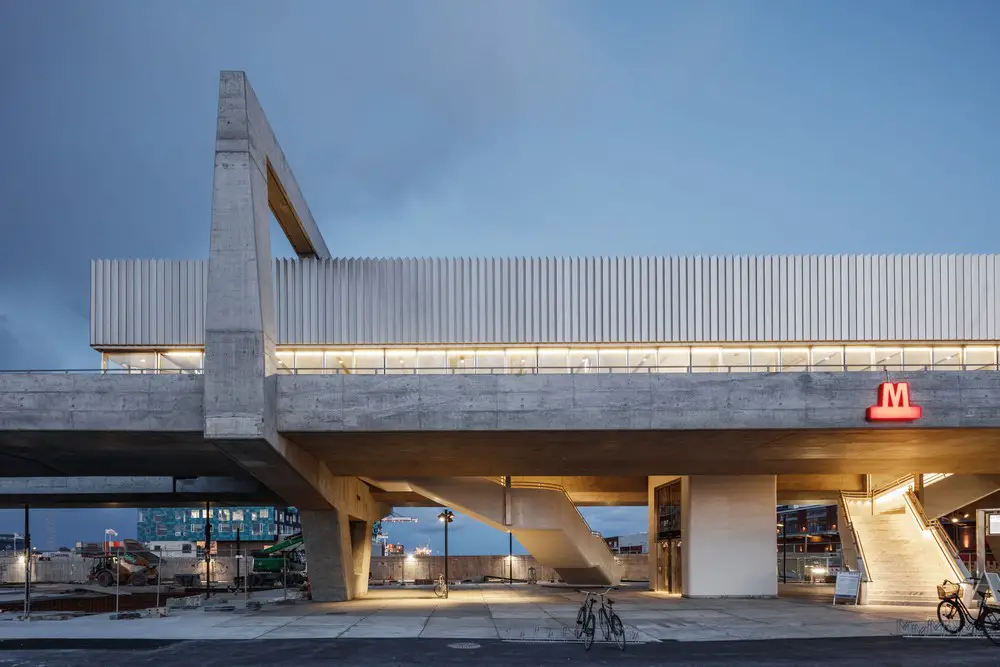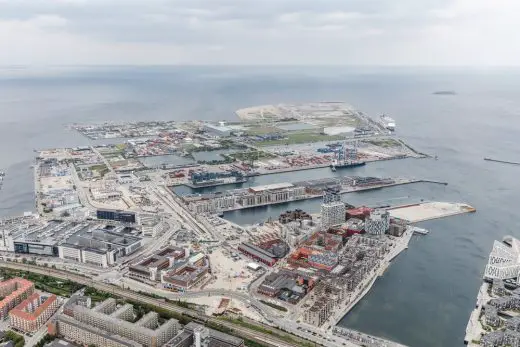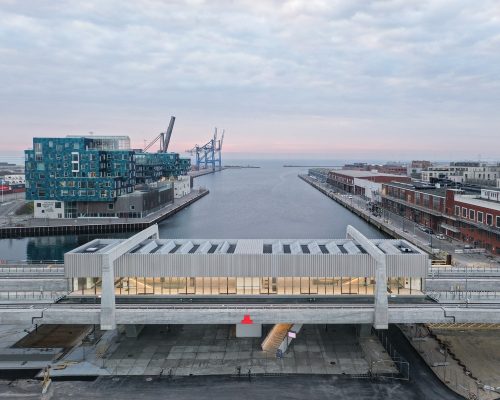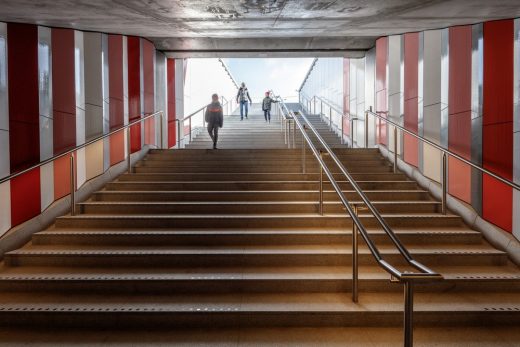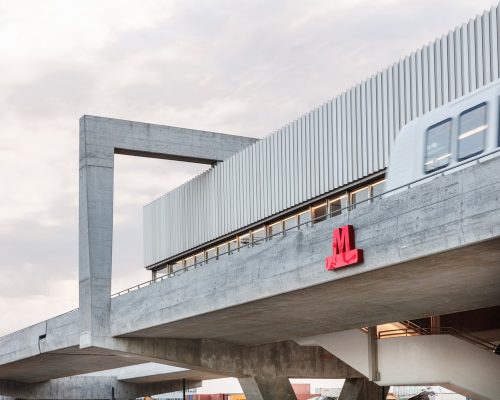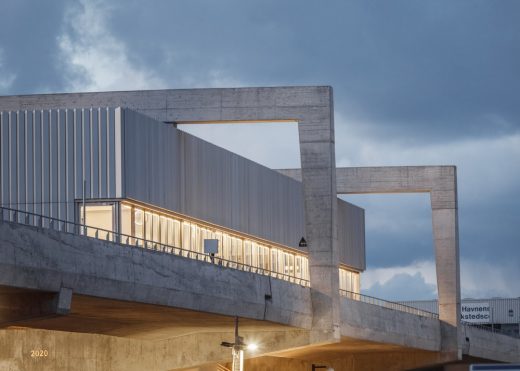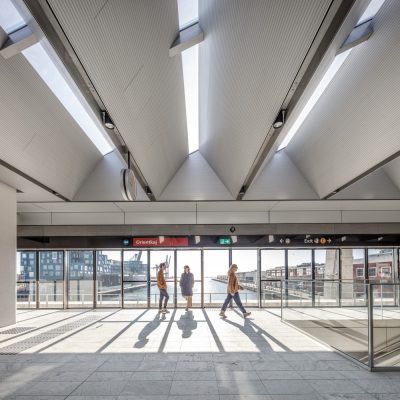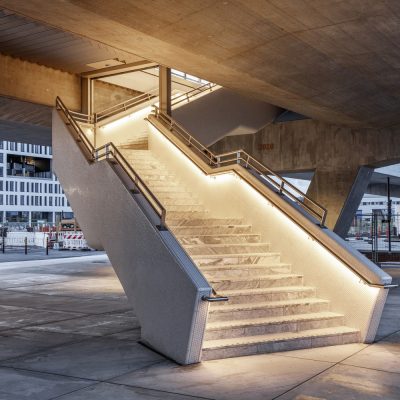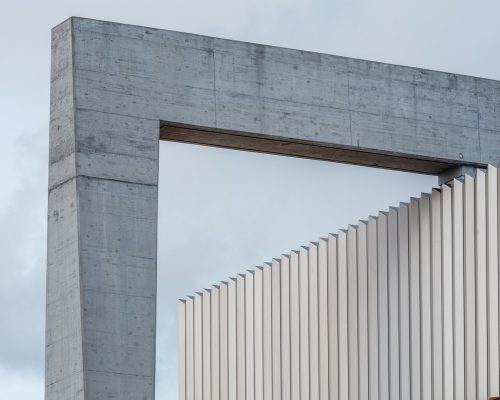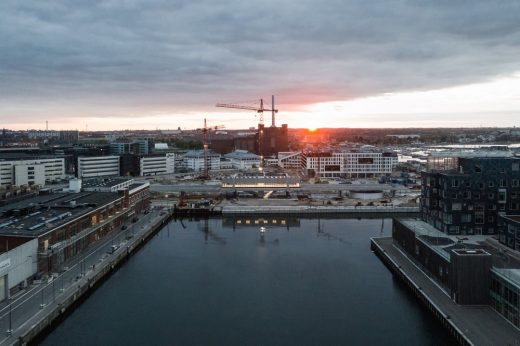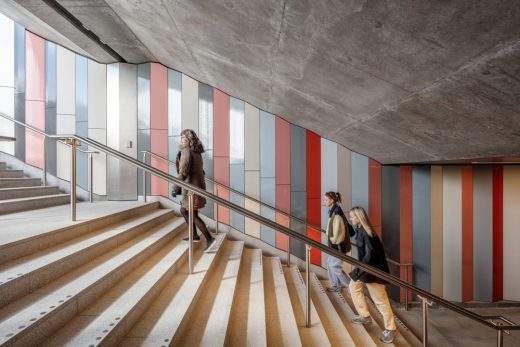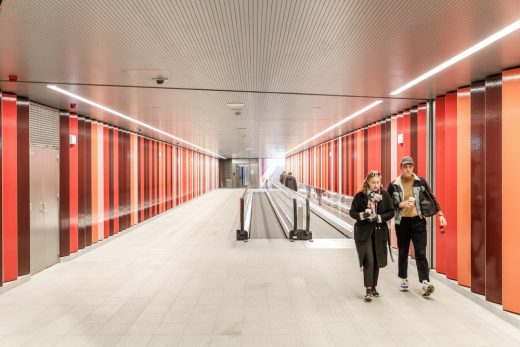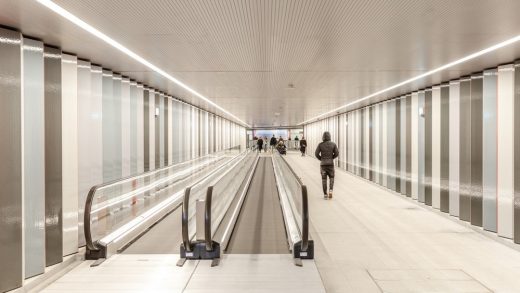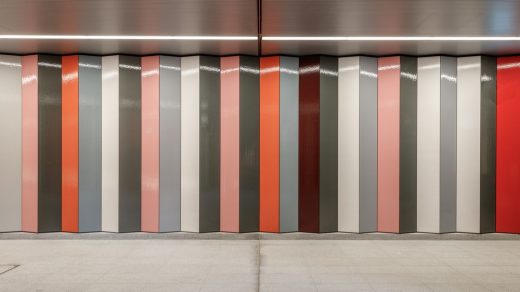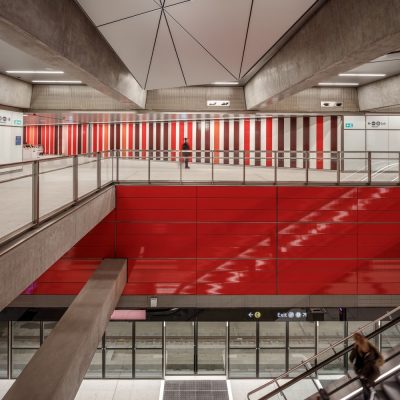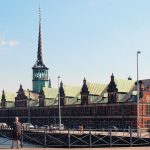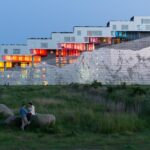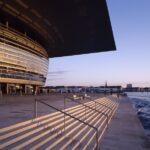Nordhavn + Orientkaj Stations Copenhagen Building, Arup and Cobe Danish Designs, Metro Architecture News
Nordhavn Station + Orientkaj Station Copenhagen
17 June 2020
Nordhavn + Orientkaj Station Buildings Copenhagen
Design: Arup and Cobe
Arup and Cobe’s new metro stations celebrate Copenhagen’s redeveloped docklands
Photos by Rasmus Hjortshøj – COAST
Part of the Nordhavn metro line extension connecting the docklands to Copenhagen’s city center, Arup and Cobe have worked together to design two new metro stations, Orientkaj and Nordhavn, under the Nordhavn metro line extension. The recently opened public transport link unlocks the potential for the redevelopment of Copenhagen’s northern docklands, one of the largest urban regeneration projects in northern Europe.
Orientkaj Station Copenhagen building by Arup and Cobe:
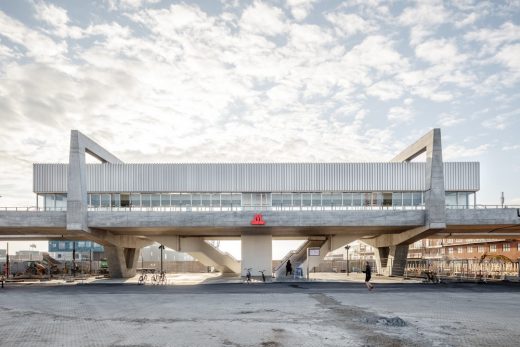
The two metro stations possess distinct visual characteristics that reflect the character of the urban areas they serve. Tracing the outline of a shipping container, the overground Orientkaj station celebrates the large-scale volumes and brutalist features of the dockland’s industrial past but opens up to reveal a passenger-focused, human-scaled detailing on the inside. The underground Nordhavn station borrows from the design vocabulary of the recently-opened Cityringen metro line – for which Arup led the architectural design – with the distinctive red cladding of transfer stations.
Nordhavn Station Copenhagen building by Arup and Cobe:
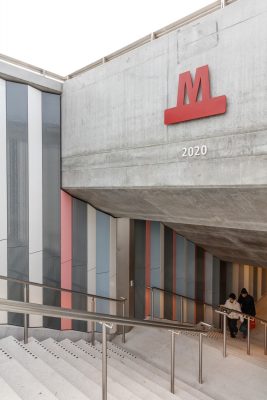
The above ground Orientkaj station has been designed as a prototype for future stations under the ongoing development of Copenhagen’s Nordhavn – a new city district, also designed by Cobe, which will add over 1,500,000 m² of sustainable mixed-use buildings and provide homes for 40,000 residents and workspaces for another 40,000.
“Nordhavn is a city of sustainable mobility, where it is easier to walk, bike or use public transport, than it is to drive your own car. The two metro stations unlock the potential of this new Copenhagen city district enabling more efficient and sustainable transport between the individual neighbourhoods, and to the rest of Copenhagen, while adding a new chapter to the story of the Copenhagen harbour front”, says Dan Stubbergaard, architect and founder of Cobe.
The two metro stations opened on 28 March 2020, with trains running from Copenhagen Central Station to Nordhavn in just four minutes. The two metro stations are expected to have 9,000 daily users by 2025.
Orientkaj station: Harbour scale meets human detailing
Anchored by bold concrete claws onto the Copenhagen harbour, the station is designed as a glass, concrete and aluminium box commandeering panoramic views over Orientkaj dock. As a prototype, Orientkaj station is designed to make a statement, offering a model for any future overground stations in the Nordhavn development. Despite the station’s scale and sharp outline, the architects’ passenger-focused approach is highlighted by the detailing inside, from the lighting to the material palette.
“The design of Orientkaj station celebrates the character and industrial past of the docklands, but most importantly, it provides a great passenger experience for visitors to this growing area of Copenhagen”, said Arup’s lead architect, Kristian Winther.
Serving a mixed-use urban area with offices, transformed warehouses and new housing developments, Orientkaj station needed to be distinctive enough to become a local landmark, while blending in with the white surrounding buildings.
Anticipating a possible future high-rise development next to the station, the architects have used anodised aluminium panels on all façades as well as roof and soffit: placed at angles, the aluminium cladding catches the colours of the sky and ensures the station offers beautiful lines of sight from all angles.
Views from the station platform have also been a key design consideration: the large, glass platform screen doors mean that on a clear day, passengers can look across the Øresund into Sweden. Two rotated, concrete staircases connect the station to the ground level. Under the station, the 33-meter long concrete spans and V-shaped piers minimise the station’s footprint while maximising the open, flexible urban space to accommodate a range of future uses, including bike lanes and a public urban space along the waterfront.
Inside the station, the vast rectangular hall is column-free, supported by the external concrete frames. Skylights mimicking the shed roofs found in the area’s former industrial buildings allow natural light to flood the station during the day, while integrated luminaries give a pleasant light at night. The scale of the brutalist concrete exterior is juxtaposed with polished detailing inside, adding a practical materiality to the station: white hexagonal mosaic covers the stairs and lift towers, while corners have been rounded for a softer, more human-friendly finish.
Nordhavn station: Design goes underground
Nordhavn station provides design continuity with the Cityringen M3 metro line, which opened in 2019, to create a seamless travel experience for passengers travelling between the two lines: platform length, information systems and wayfinding are the same, while the interior façades are clad in the red tiles characteristic of Cityringen’s interchange stations.
An underground transfer station at Nordhavn S-train lies under a busy traffic artery. Intuitive wayfinding was a key design consideration for this underground station with clear lines of sight between the underground station and the transfer tunnels, allowing users to see all the way through to the other side, enhancing the feeling of comfort and safety.
Folded ceramic panels also provide a sense of movement, building to a great reveal in the transfer tunnel: the angled wall claddings reveal a different hue changing from white to red as passengers move through.
Continuing another design theme from Cityringen, the new metro station’s origami ceiling has been designed to reflect light throughout.
About Arup and Cobe’s role in the project
Arup and Cobe worked together on the architectural design of the two new stations: Orientkaj and Nordhavn. Always credit both companies in connection with mentioning the project.
As part of a Joint Venture with Rambøll, Arup also delivered a broad range of services including geotechnics, structural engineering, passenger modelling, construction planning, lighting design, and fire and life safety of the project.
In addition, Cobe, in collaboration with Sleth and Polyform, also designed the urban spaces surrounding the two metro stations.
Orientkaj Station Copenhagen building:
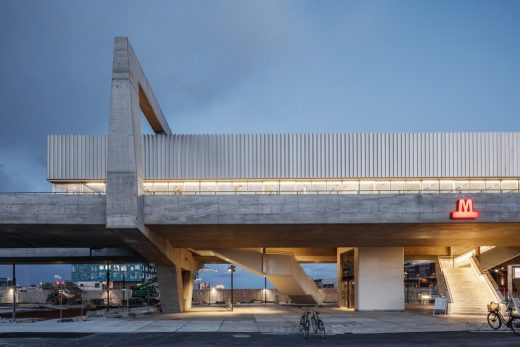
About Arup
Arup is an independent firm of more than 14,000 designers, planners, engineers, architects, consultants and technical specialists, working across 33 countries on every aspect of today’s built environment. Together we help our clients solve their most complex challenges – turning exciting ideas into tangible reality as we strive to find a better way and shape a better world.
About Cobe
Cobe is an architecture firm founded in Copenhagen, DK, in 2006 by the architect Dan Stubbergaard, and aspires to create surroundings that actively contribute to extraordinary everyday life. Among the firm’s most distinctive projects are The Silo in Copenhagen’s Northern docklands, the urban space Karen Blixens Plads at Copenhagen’s University, and HALFTIME at adidas’ headquarters in Germany.
Nordhavn Station Copenhagen building by Arup and Cobe:
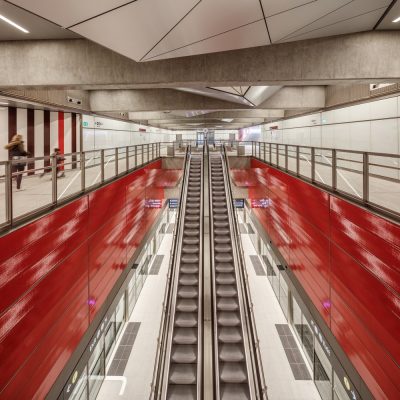
Nordhavn station Copenhagen – Building Information
Client: Metroselskabet
Year: 2013-2020
Size: Platform 44 x 7 metre
Architects: Arup and Cobe
Architectural finishes: CAS JV
Engineers: RambøllArup JV
Contractor: Metnord
Lighting design: Arup
Landscape architects: Cobe, Sleth and Polyform
Orientkaj Station building Copenhagen:
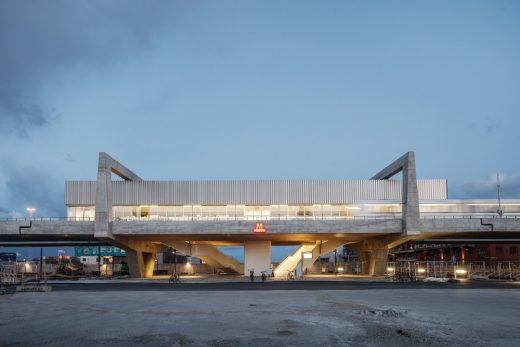
Orientkaj Station Copenhagen – Building Information
Client: Metroselskabet
Year: 2013-2020
Size: Platform 44 x 9 metre
Architects: Arup and Cobe
Engineers: RambøllArup JV
Contractor: Metnord
Lighting design: Arup
Landscape architects: Cobe, Sleth and Polyform
Elevated railway
Client: Metroselskabet
Year: 2013-2020
Architects: Arup and Cobe
Engineers: RambøllArup JV
Photographer: Rasmus Hjortshøj – COAST
Nordhavn + Orientkaj Stations Copenhagen images / information from COBE
Another Copenhagen Station building design by COBE:
Nørreport Station Nominations
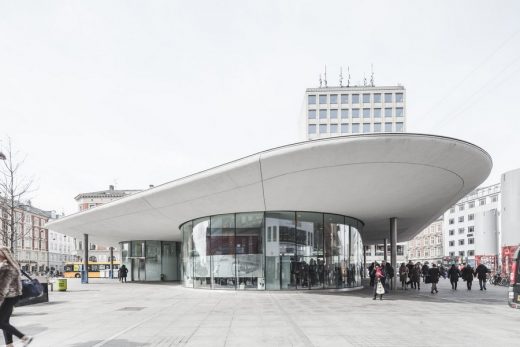
images : COBE + Public Architects
Nørreport Station Copenhagen
Location: Copenhagen, Denmark
Copenhagen Architecture
A recent major architectural intervention in the Danish capital by Cobe on e-architect:
Karen Blixens Plads, Copenhagen, Denmark
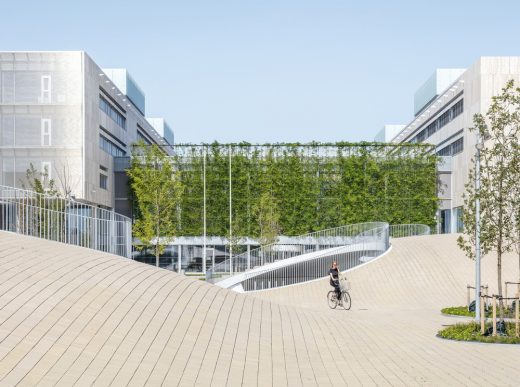
photograph : Rasmus Hjortshøj
Karen Blixens Plads
Copenhagen Railway Station / Hovedbanegaarden
Design: Heinrich Wenck Architect
Copenhagen Railway Station
Taastrup Theatre Building design by COBE
Comments / photos for the Nordhavn + Orientkaj Stations Copenhagen Architecture page welcome

